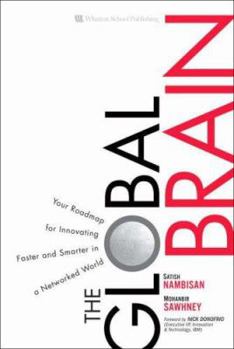The Global Brain: Your Roadmap for Innovating Faster and Smarter in a Networked World
Select Format
Select Condition 
Book Overview
All the talk about open innovation and externally-focused innovation assumes that one size fits all in terms of what network-centric innovation is and how companies should harness external creativity.... This description may be from another edition of this product.
Format:Hardcover
Language:English
ISBN:013233951X
ISBN13:9780132339513
Release Date:January 2007
Publisher:Wharton School Publishing
Length:276 Pages
Weight:1.14 lbs.
Dimensions:1.1" x 6.3" x 9.2"
Customer Reviews
4 ratings
Useful guide to speedy innovation
Published by Thriftbooks.com User , 15 years ago
The idea of the "Global Brain" is not brand-new. However, as India's and China's economies continue to expand, and as their workforces' technical expertise booms, this concept is becoming increasingly important in the business world. Modern companies must tap into ideas, talent and technology from around the globe to stay competitive. Satish Nambisan and Mohanbir Sawhney present a framework for thinking about and using "network-centric innovation" (NCI) in your firm. Although they intend their book to be practical, readers may find it more theoretical. The authors explain their models clearly, using helpful metaphors and anecdotes, but it will be up to you to find a way to implement them. getAbstract recommends this book to executives, research and development professionals, and managers who want to close the gap between "the desire to innovate and the ability to innovate."
the gobal brain
Published by Thriftbooks.com User , 16 years ago
"The gobal brain" and the models for networks elucidated therein in detail provided an highly interesting theoretical basis for a newly developed IT technology ("collaborative network portal (CNP)") by our start-up company, bv cluster (the Netherlands), dedicated to improve the efficiency/efectiveness of open (R & D) innovation projects in network environments. It ("The global brain") helped us to identify important dimensions in open R & D projects in network environments. We can use it for improvement of our implementation methodology of this CNP technology. Great stuff for our company and it confirmed that we are on the right track with our approach.
How to communicate, cooperate, and collaborate effectively in a "flat world"
Published by Thriftbooks.com User , 17 years ago
With regard to the term Global Brain, Satish Nambisan and Mohanbir Sawhney refer to "the diverse set of external players that constitute the innovation network for the companies" discussed in this book such as P & G, IBM, Boeing, and Apple]; and Network-centric innovation to describe "the underlying principles of collaborative innovation in such a context." They add that a common theme n their research was their interest in the concept of distributed innovation. That is, "innovation initiatives that are spread across a diverse network of partners." Their vehicle for exploration was the Kellogg Innovation Network (KIN) -- "a forum for senior innovation managers of large companies - affiliated with the Center for Research in Information and Technology that [Sawhney] directs at the Kellogg School of Management. The KIN is an excellent example of the power of the Global Brain in action." Nambisan and Sawhney carefully organize and present their material within five Parts. During the course of their narrative, they respond to questions such as these: Why should companies seek innovation externally during a transition from being firm-centric and network-centric? What are the core principles of network-centric innovation? What are the four basic models and key elements of network-centric innovation? How to develop a contingent framework that maps the context for innovation? Which guidelines can help managers to evaluate the different types of opportunities that are most appropriate to their organization's resources, capabilities, and strategies? What are the implications of network-centric innovation for the emerging economies? What are the common trends in various countries' emerging economies? How to analyze the potential for companies in these countries to "plug into the global brain"? I especially appreciate Nambisan and Sawhney's provision of dozens of real-world examples that illustrate their key points. For example, in Chapter 5 they examine what they characterize as "the orchestra model" that can take two quite different forms: The Orchestra-Integrator model and the Orchestra-Platform model. With regard to the former, they examine Boeing's 787 Dreamliner project and include Table 5.1 (Pages 96-97) that portrays the project's specific elements of network-centric innovation. With regard to the Orchestra-Platform Model, they examine Salesforce.com and the AppExchange Forum. Figure 5.3 (Pages 110-111) illustrates the elements of its network-centric innovation. "In both the Integrator and Platform model, the innovation architecture defined by the dominant firm becomes the context for the network partners to innovate...In both cases, the tricky part is to bring together a diverse set of capable partners who are sufficiently committed to the innovation architecture and to orchestrate their activities in a manner that leads to outcomes that are beneficial to all the network members." After completing their exploration of the Global Brain
The Global Brain is absolutely brilliant!
Published by Thriftbooks.com User , 17 years ago
The Global Brain is absolutely brilliant. The authors build upon insightful theoretical and practical bases to guide managers through the vast array of innovation sourcing options. They employ an eclectic combination of practical examples from numerous industries and sectors, indicating the global appeal of the ideas of this book. Managers have four models, which they can choose from: (1) The Orchestra Model (2) The Creative Bazaar Model (3) The Jam Central Model & (4) The MOD ("MODification") Station Model The use of these inspiring entertainment industry metaphors to model network-centric innovation enables the authors to describe how managers can make sense of the vast array of innovation opportunities that exist in their ecosystem. The notion that a company can play different innovation roles while employing one of the four models of network-centric innovation helps bring home the fundamental caution of this book, which is "in a world of network-centric innovation, one size does not fit all".





